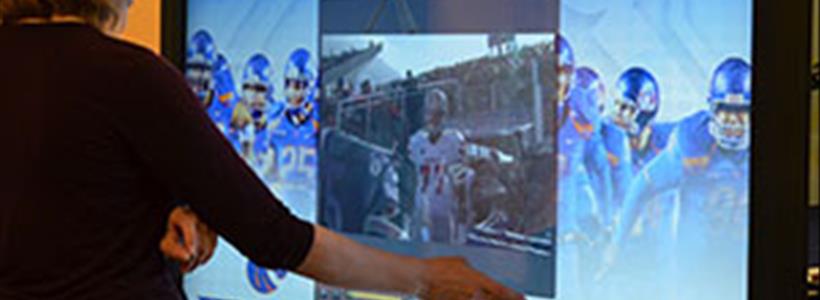
Apr
29
2015
Advances in technology are great, aren’t they? And nowadays, the speed in advancement has made the newest technologies affordable to the masses at a much faster pace. Because of this, museum exhibit managers have more options than ever for their technology based and touch screen exhibits.
Computer and video displays in general (monitors) have been growing in size over the years. And with that, touch screen displays are also growing. Just a few short years ago the “standard” size for touch screen kiosk displays was 15 inches and 17 inches if the museum really wanted a “big” one. Now with the plummeting costs of touch screen technology, it’s common to utilize 27 inch, 32 inch or even larger touch screens for an interactive program or game and the advantages are substantial.
More Real Estate. Obviously, the larger screens allow for more space on the screen for imagery and text but is that really an important advantage for museum educators? Sure it is. In the past a photo or 2 could be placed on a single “screen” with a moderate amount of text for description and instructions. With larger areas available, multiple photos and more detailed text can be utilized on a single “screen” of your program or game. “Sound bite” type text can be utilized for grabbing attention and for the “non-readers” you have AND detailed information can also be available to those who desire more info. You still want to be aware of type size and remember to keep things large enough for easy reading, but with more space comes the ability to add content (and content is King, right?).
More Eye Catching. Walk down Las Vegas Boulevard if you want to see how effective large screens are at getting attention. Though most museums don’t want to look like the Vegas Strip, all want their educational content to be seen. With larger touch screen displays (42 inch and larger) this visual element of the exhibit is substantial. Previously, with smaller touch screen kiosks and displays, these interactive games and programs appeared to be “add ons” to the larger visual content. Now large screens can make the electronic components of the museum exhibit focus points and visually complementary to the overall visual impression. With this in mind, museum exhibit designers should give more consideration on attract screens and the visual impact of all large screen components.
Less Cabinetry. For very large screens, placing them in a kiosk cabinet may not be a great solution. The size of a 42+ inch touch screen display would require a very large footprint kiosk cabinet to accommodate the screen and to provide the required stability. Many museums can’t give up that much floor space to a large kiosk. That being said, large LCD touch screens lend themselves very well to wall mounting. Standard brackets and LCD display mounts can be used on any large touch screen. The advantages of this are that no floor space is required and that there is no cabinetry to maintain, clean, etc. Large touch screens can also be mounted into a large “reader rail” type of display. One thing to keep in mind when wall mounting a LCD touch screen is that even though it’s not a kiosk “per se,” you will need to provide accessibility for the disabled according to the ADA requirements. That simply means that you need to have the appropriate floor space for a wheelchair to navigate and that the height requirements need to be adhered to.
Large touch screen interactives are great additions to captivating museum exhibits. Here at point2explore we’re providing more and more larger screens to our clients and the results are great. For one example of a touch screen educational program we’ve developed using a larger screen, check out our case study of a project we completed for the Museum of Flight’s Space Shuttle exhibit.
If you have comments or questions please comment here or give us a call or send us an email.
Chris Meyer
President
CD Meyer, Inc./point2explore
point2explore is product line of customizable touch screen kiosk programs including interactive games and informational programs. point2explore products are currently running in over 100 museums and have been used in corporate events across the country. Visit our web site at http://www.point2explore.com.